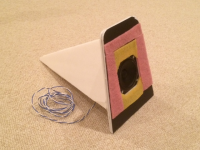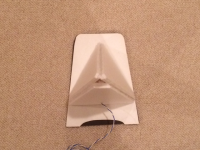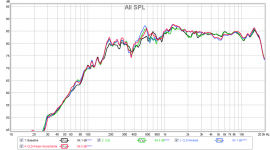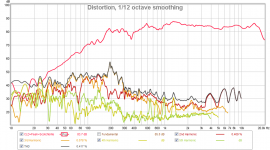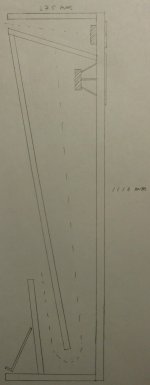FYI, these are 10:1 taper ratio TQWTs; 1:10 would be a conic [horn] expansion.
It's just thee & me fighting for the old ways Greg... 😀
OK, I don't know what the binder is, so assumed it was some sort of spirits based.
BTW, the cork I've used is the thicker decorator patterns: https://www.google.com/search?q=dec...rk.net%2Fdesigner-cork-walltiles.html;250;161
GM
Yeah, I've seen the decorator cork, thick cork tiles, and all sorts of variations. I'd imagine the availability varies drastically by location. Some of those might be nice for covering a whole speaker, and they are somewhat functional as well.
I don't know what binders are commonly used. If it's like plywood, it could be just about anything.
I will post more info later but the short story with the TC9FD: do not rebate and flush mount. The way it is designed it is flatter and smoother when surface mounted. A real time saver for DIY builds with this driver. Kind of silly but I will have to un-rebate the bezel and go back to surface mount.
Interesting result and thanks for testing!!😀 This will make everything easier.
One thought: while they may have been developed for smoothest FR when surface mounted, there still is going to be more edge diffraction that way. They might be a little cleaner and image better if flush mounted, despite being less even. Freq response is overrated.
It's just thee & me fighting for the old ways Greg... 😀
Fighting for the old ways as opposed to the really old ways (Voigt patent) which are also today's standard meaning.
dave
Interesting result and thanks for testing!!😀 This will make everything easier.
One thought: while they may have been developed for smoothest FR when surface mounted, there still is going to be more edge diffraction that way. They might be a little cleaner and image better if flush mounted, despite being less even. Freq response is overrated.
Doesn't diffraction show up in frequency response? I made the baffle a trapezoid to avoid having equal distances cause edge diffraction cancellation. i made the TL walls out of three long triangles to avoid any flat-flat surfaces for standing modes. Only thing I haven't tried is felt around driver. I remember Dunlavey speakers having felt or Velcro around tweeters - for enhanced imaging.
Member
Joined 2009
Paid Member
Hi Sreten,
for some reason I kept a note on my computer of some advice you posted around here on the forum in case it was useful for deciding on my own projects, sorry I can't remember how old this is but would be interested to know if this (quoted below) is still your opinion ?
"...But the best sounding bass I ever got was from a good quality driver of about qts .35 in a cabinet size that would have been about a Q of .6 in a sealed alignment and then used a resistive vent. Bass was amazing in quality. Almost as transient perfect as a good TL but with better weight and amazing pitch definition. My brother in law is now using them as mixing monitors."
for some reason I kept a note on my computer of some advice you posted around here on the forum in case it was useful for deciding on my own projects, sorry I can't remember how old this is but would be interested to know if this (quoted below) is still your opinion ?
"...But the best sounding bass I ever got was from a good quality driver of about qts .35 in a cabinet size that would have been about a Q of .6 in a sealed alignment and then used a resistive vent. Bass was amazing in quality. Almost as transient perfect as a good TL but with better weight and amazing pitch definition. My brother in law is now using them as mixing monitors."
Effect of Flush Mounting
I did some measurements of the TC9FD and other drivers in a short TL test enclosure built specifically for looking at details of frequency response and impulse response for a new thread (to be posted later). The TL is very simple: made from 3 triangles with a 6.67 in wide base x 15 in high (all in foam core of course, and the pieces sized so that 6 panels can be obtained from a single 20in x 30in sheet of FC 🙂 ) and glued together to form a 3-sided tall pyramid, which I will call the "Dagger" TL. The vertex of the TL has a small opening on one of the triangles to serve as the terminus vent while still preserving the Dagger pointy aesthetic. The inside is filled with polyfill and a trapezoidal baffle is glued onto the front to reduce the effects of baffle diffraction. The walls of the Dagger were later doubled up with latex caulking layer sandwiched for constrained layer damping (CLD). When a second layer was added to the front for flush mounting, CLD was used as well.
Here is a photo of the completed Dagger, shown with the TC9FD and fully decked out with the flush rebate layer and some additional trim of thin scotchbrite-type scrubbing pads added around the driver to smooth out the response. Measurements were made with mic at 0.5m distance, TPA3116D2 amp driven full range with no filters (circa 1.4V), with UMM-6 calibrated mic:
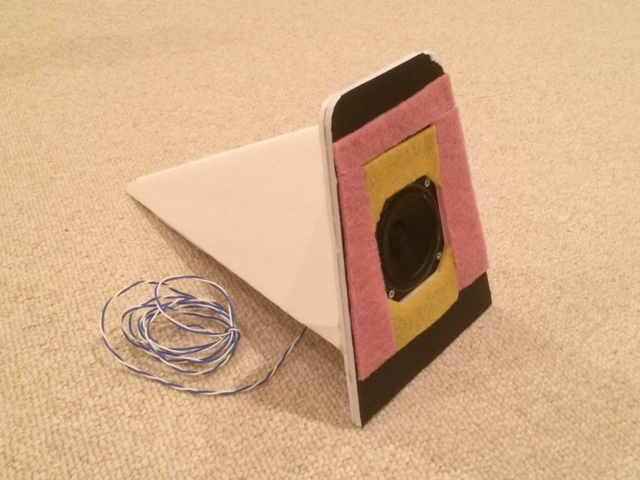
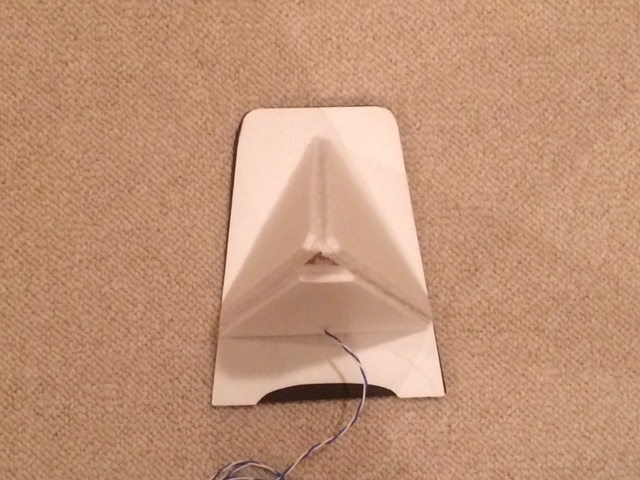
Here is the frequency response of the TC9FD for 4 cases (baseline, with CLD, with CLD+flush rebate, CLD+flush rebate+scotchbrite):
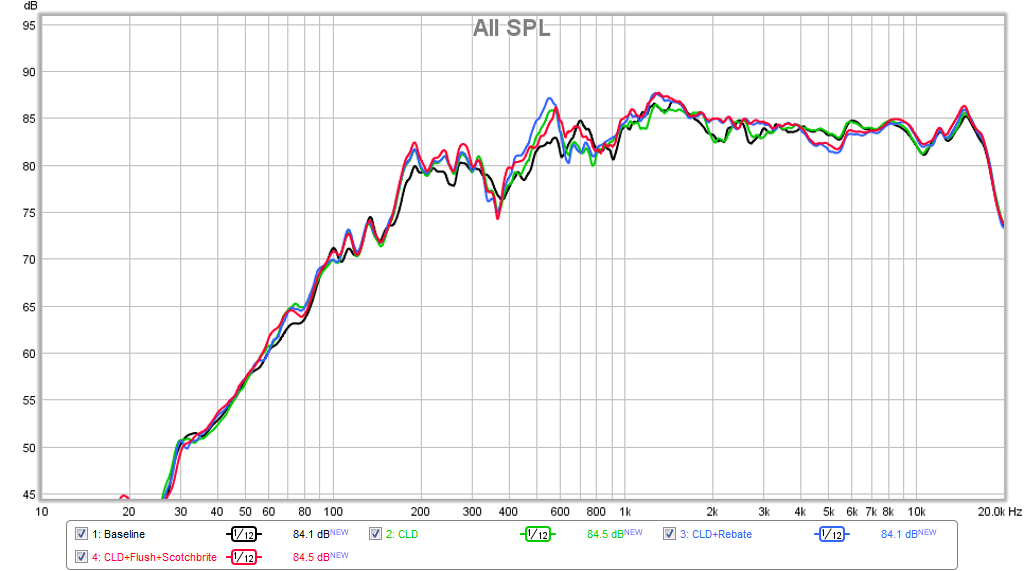
I think I prefer the overall flatness of the non-flush mounting, however, the flush mounting does *smooth* the response from 1.5kHz to 4kHz. Otherwise, it actually causes a peak at 1.3kHz and a rather wide and large dip at 5.5kHz. Seems like more trouble than it's worth. Adding the scotchbrite seems to have improved the smoothness from 400Hz to 1kHz, and may appear to be a worthwhile addition. I don't have a stereo pair, but maybe as GregB suggests, the flush rebate will improve the imaging due to the reduced wiggle in the 1.5kHz to 4kHz range where much of our psychoacoustic clues for spatial imaging comes from. The performance from 400Hz to 20kHz is actually quite good, and this would probably make a fine top for a FAST system with a XO around 350Hz to 400Hz.
Here is harmonic distortion:
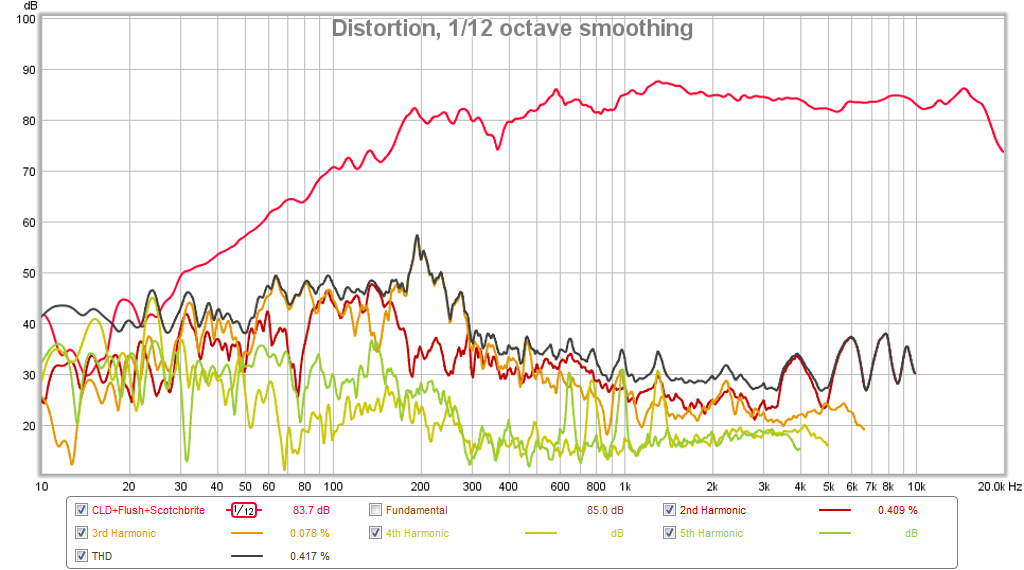
I am making some careful measurements of response of TC9FD and other drivers in a short tapered TL and will try adding a flush mount rebate and felt to see if the 1-2dB wiggle can be reduced. The TL definitely flattens the impedance peak - but that is at fs near 130Hz, more than an octave below where I would XO as a FAST. However, the midrange does seem very open.
I did some measurements of the TC9FD and other drivers in a short TL test enclosure built specifically for looking at details of frequency response and impulse response for a new thread (to be posted later). The TL is very simple: made from 3 triangles with a 6.67 in wide base x 15 in high (all in foam core of course, and the pieces sized so that 6 panels can be obtained from a single 20in x 30in sheet of FC 🙂 ) and glued together to form a 3-sided tall pyramid, which I will call the "Dagger" TL. The vertex of the TL has a small opening on one of the triangles to serve as the terminus vent while still preserving the Dagger pointy aesthetic. The inside is filled with polyfill and a trapezoidal baffle is glued onto the front to reduce the effects of baffle diffraction. The walls of the Dagger were later doubled up with latex caulking layer sandwiched for constrained layer damping (CLD). When a second layer was added to the front for flush mounting, CLD was used as well.
Here is a photo of the completed Dagger, shown with the TC9FD and fully decked out with the flush rebate layer and some additional trim of thin scotchbrite-type scrubbing pads added around the driver to smooth out the response. Measurements were made with mic at 0.5m distance, TPA3116D2 amp driven full range with no filters (circa 1.4V), with UMM-6 calibrated mic:


Here is the frequency response of the TC9FD for 4 cases (baseline, with CLD, with CLD+flush rebate, CLD+flush rebate+scotchbrite):

I think I prefer the overall flatness of the non-flush mounting, however, the flush mounting does *smooth* the response from 1.5kHz to 4kHz. Otherwise, it actually causes a peak at 1.3kHz and a rather wide and large dip at 5.5kHz. Seems like more trouble than it's worth. Adding the scotchbrite seems to have improved the smoothness from 400Hz to 1kHz, and may appear to be a worthwhile addition. I don't have a stereo pair, but maybe as GregB suggests, the flush rebate will improve the imaging due to the reduced wiggle in the 1.5kHz to 4kHz range where much of our psychoacoustic clues for spatial imaging comes from. The performance from 400Hz to 20kHz is actually quite good, and this would probably make a fine top for a FAST system with a XO around 350Hz to 400Hz.
Here is harmonic distortion:

Attachments
Last edited:
Nice work xrk, interesting findings you obtained. I wonder how flush mounting into a "fake baffle" (like the cork sheet over the real baffle) would measure.
Went to see the gasket rubber cork today, that road is a no-go. It smelled absolutely terrible, got a headache from the stuff instantly. Asked around craft stores a bit, it seems they some supply cork but it's on pretty small sheets. Ideally I'd like to find large granule cork as it looks the prettiest to my eye.
Plan so far is to build an enclosure like I posted earlier (I'll reattach it here with some added measurements and questions). Would the full range enclosure work with only 9,8" line lenght? The plan is to XO at the baffle step, around 380Hz. Also a question about the line width on the part of the line where the woofer is located. Should I try to narrow this bit somehow? Could I run into troubles if I leave it as it is?
Follow up-question on the space behind the enclosure. There's a lot of empty room in there after the woofer TL opening. Should I pad the side walls with profiled foam or is it just pointless? Also taking crazy ideas what I could do with all that space 😀
Third question about the padding. Would recycled felt work and should I line the TL insides with it? I got a 8mm thick sheet of it already. Stuff like this:
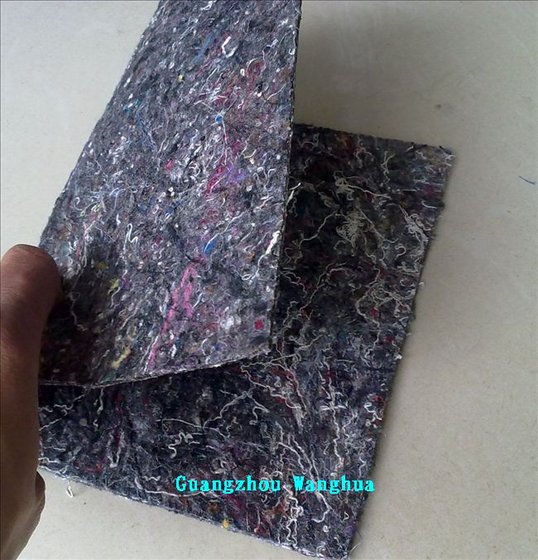
Fourth question about driver offset. As the baffle is quite wide (27cm, 30 with sides) I can offset the drivers quite a bit. Is there any golden rule for this or should I just offset so that no distance from driver to baffle edge is similar?
I also want to thank everyone who's given me advice in this project. I'm pretty sure these speakers will turn out a lot better than they would have unless you wouldn't have helped me along the way.
Went to see the gasket rubber cork today, that road is a no-go. It smelled absolutely terrible, got a headache from the stuff instantly. Asked around craft stores a bit, it seems they some supply cork but it's on pretty small sheets. Ideally I'd like to find large granule cork as it looks the prettiest to my eye.
Plan so far is to build an enclosure like I posted earlier (I'll reattach it here with some added measurements and questions). Would the full range enclosure work with only 9,8" line lenght? The plan is to XO at the baffle step, around 380Hz. Also a question about the line width on the part of the line where the woofer is located. Should I try to narrow this bit somehow? Could I run into troubles if I leave it as it is?
Follow up-question on the space behind the enclosure. There's a lot of empty room in there after the woofer TL opening. Should I pad the side walls with profiled foam or is it just pointless? Also taking crazy ideas what I could do with all that space 😀
Third question about the padding. Would recycled felt work and should I line the TL insides with it? I got a 8mm thick sheet of it already. Stuff like this:

Fourth question about driver offset. As the baffle is quite wide (27cm, 30 with sides) I can offset the drivers quite a bit. Is there any golden rule for this or should I just offset so that no distance from driver to baffle edge is similar?
I also want to thank everyone who's given me advice in this project. I'm pretty sure these speakers will turn out a lot better than they would have unless you wouldn't have helped me along the way.
Attachments
Last edited:
Mayuri,
How did you come up with the bass TL design? Looks like you are looking for a tapered TQWT type TL? It needs to be designed based on a simulation, or at least with some guideline otherwise you are guessing and that probably will it be optimal. What is your bass extension goal and what are the max dimensions? You may even consider a straight MLTL as that is simpler to design and make.
How did you come up with the bass TL design? Looks like you are looking for a tapered TQWT type TL? It needs to be designed based on a simulation, or at least with some guideline otherwise you are guessing and that probably will it be optimal. What is your bass extension goal and what are the max dimensions? You may even consider a straight MLTL as that is simpler to design and make.
Scottmoose gave the idea and I posted the simulation results earlier in this thread: http://www.diyaudio.com/forums/full-range/268037-fast-tl-2.html#post4187412Mayuri,
How did you come up with the bass TL design? Looks like you are looking for a tapered TQWT type TL? It needs to be designed based on a simulation, or at least with some guideline otherwise you are guessing and that probably will it be optimal. What is your bass extension goal and what are the max dimensions? You may even consider a straight MLTL as that is simpler to design and make.
The TL is folded so that the full range speaker is on ear level from listening place. Ignore the stuffing part, that's still under work. The bass peak at 50Hz will be gone whilst the line is properly stuffed as shown in simulations in page 1. http://www.diyaudio.com/forums/full-range/268037-fast-tl.html#post4186981 In general, I think the woofer TL would require quite a bit of stuffing. Can't remember what MJK uses, was it 2lb/cf in his worksheets?
EDIT: Max dimensions are about 120cm tall, 36cm wide and deep.
Last edited:
Ok, I wasn't sure what all the extra stuff on the bottom was for and it looks like you are trying to fold it at the top by 90 deg. The turn is so small that the line will act as if the length is simply the top wall. You need to fold at the bottom and extend up after 180.
Alright, made a new drawing. Paint is quite inaccurate, so I just took a picture of the physical drawing. The 275mm (up) is without the front baffle, which is 24mm more. All spaces have a little extra to glue 8mm felt on every surface. Measures are so that it is 1:5 miniature on paper.
Attachments
That looks good now - as long as you build according to the sim dimensions it is good. Felt is porous - I would not add extra space as that will increase your volume beyond the sim volume.
Mayuri,
Input to your fourth question #68 the info is based on simulation from freeware "The Edge".
Off setting drivers gives smother frequency response on axis but if moving to same off axis angle at left relative to right of speaker it would not have same frequency response signature.
Both drivers placed on vertical center line have less smooth frequency response but have symmetry in horizontal plane, example listener placed 20º left of speaker will have same frequency response signature as if placed 20º right of of speaker.
Input to your fourth question #68 the info is based on simulation from freeware "The Edge".
Off setting drivers gives smother frequency response on axis but if moving to same off axis angle at left relative to right of speaker it would not have same frequency response signature.
Both drivers placed on vertical center line have less smooth frequency response but have symmetry in horizontal plane, example listener placed 20º left of speaker will have same frequency response signature as if placed 20º right of of speaker.
The TC9FD as mounted in the Dagger TL works quite well in a FAST with a -24dB/oct BW XO at 400Hz. I am using a 5in Tang Band W5-876SE for the woofer in a HYpercube sealed enclosure and a miniDSP for the EQ and XO with a TPA3116D2 amp.
Here is the setup - not the nicest looking speaker but really meant to be a test bed for ultimate clean temporal response testing, not looks...
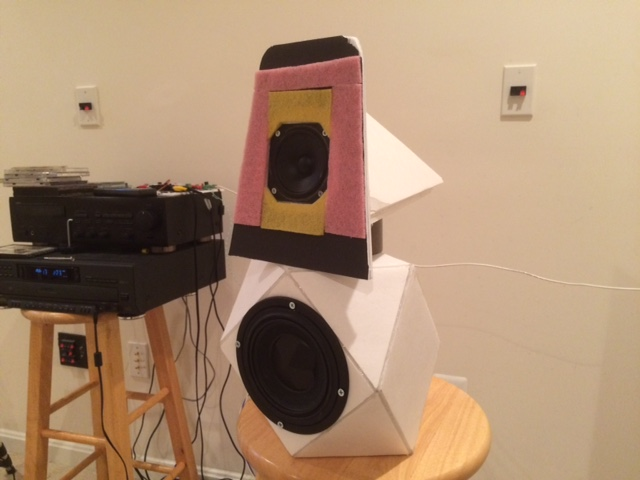
Here are the measurements of this FAST (which with a miniDSP and amps ready to go, took 15 minutes to set up and tune, really fast, actually).
Here is the frequency response and XO setup, the black curve is with some mild EQ to level it out, +/- 3dB from 60Hz to 20kHz, and +/-2dB from 300Hz to 18kHz, not too bad...:
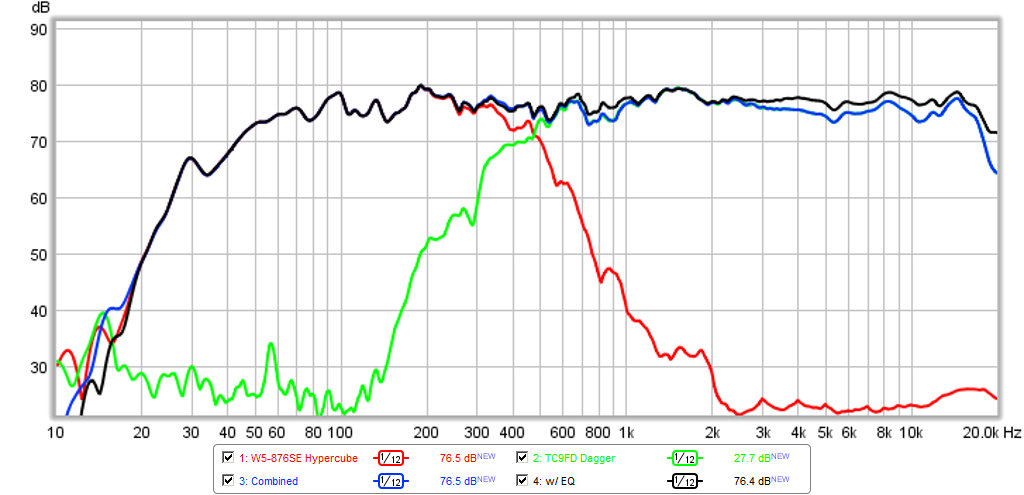
Here is the minimum phase response - excellent +/- 15 deg from 200Hz to 15kHz, meaning if I had a stereo setup it would have very phase-accurate psychoacoustics like sound stage and phantom imaging:
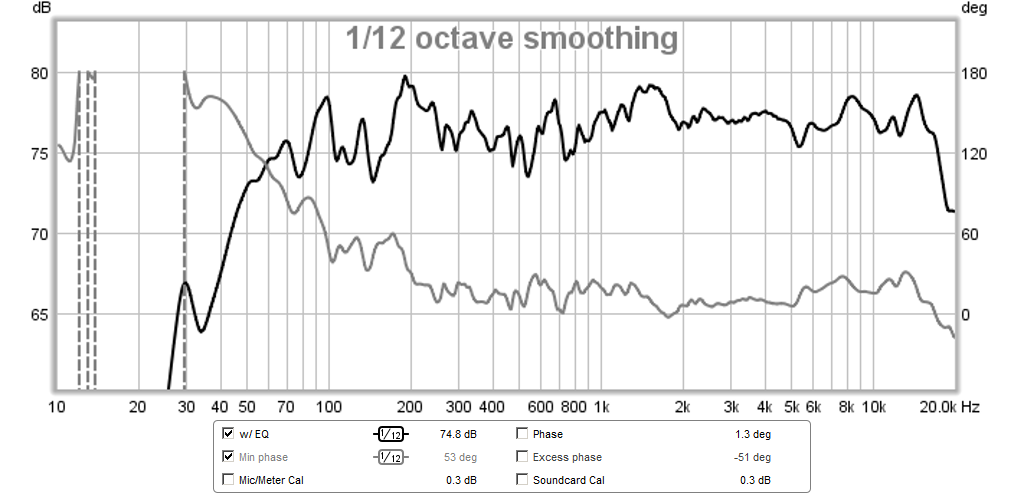
Here is the impulse response - doesn't get much cleaner than that unless one were to use a DSP convolver:
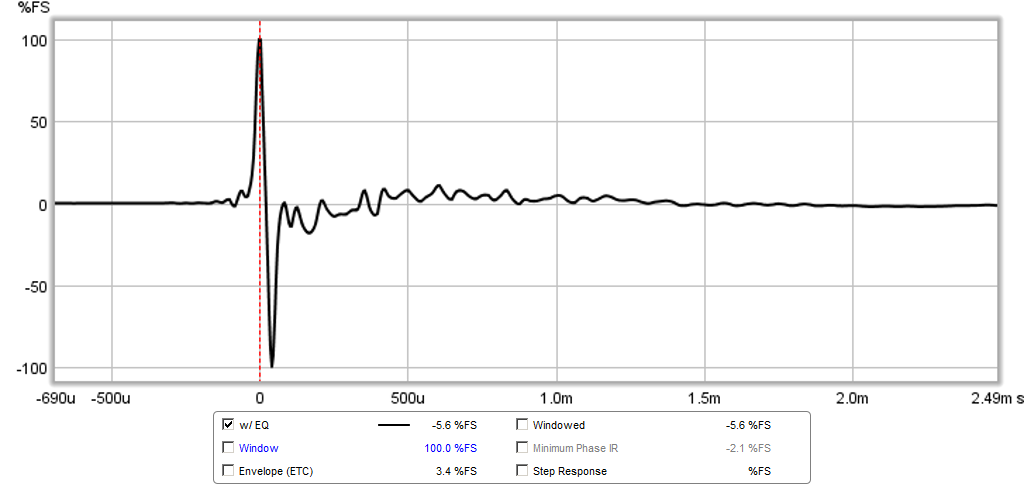
Here is the harmonic distortion which is very good from 400Hz on up:
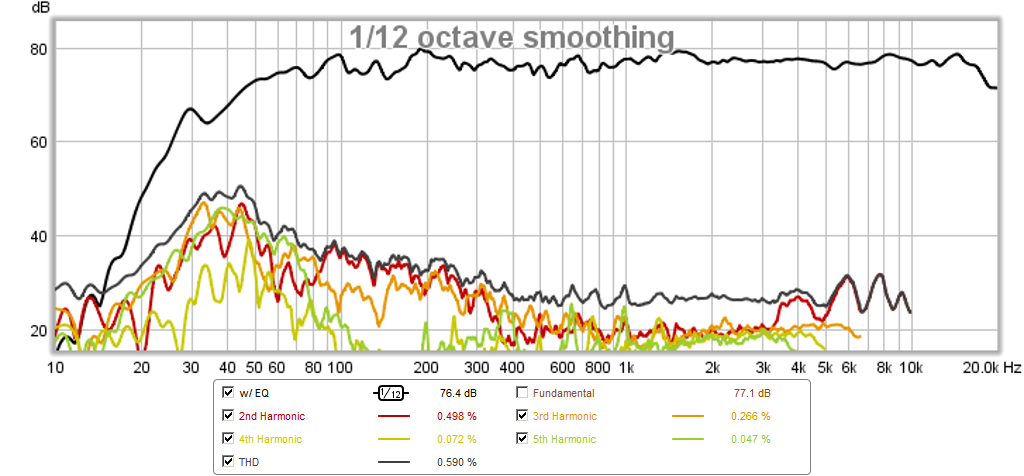
Finally, here are some sound clips (mono right channel) - I think you will find the TC9FD in a short vented TL sounds very balanced, open, very nice.
Here is the setup - not the nicest looking speaker but really meant to be a test bed for ultimate clean temporal response testing, not looks...

Here are the measurements of this FAST (which with a miniDSP and amps ready to go, took 15 minutes to set up and tune, really fast, actually).
Here is the frequency response and XO setup, the black curve is with some mild EQ to level it out, +/- 3dB from 60Hz to 20kHz, and +/-2dB from 300Hz to 18kHz, not too bad...:

Here is the minimum phase response - excellent +/- 15 deg from 200Hz to 15kHz, meaning if I had a stereo setup it would have very phase-accurate psychoacoustics like sound stage and phantom imaging:

Here is the impulse response - doesn't get much cleaner than that unless one were to use a DSP convolver:

Here is the harmonic distortion which is very good from 400Hz on up:

Finally, here are some sound clips (mono right channel) - I think you will find the TC9FD in a short vented TL sounds very balanced, open, very nice.
Attachments
-
Dagger-FAST-Clip-ZB-02.zip916.8 KB · Views: 134
-
Dagger-FAST-Clip-RP-01.zip919.9 KB · Views: 231
-
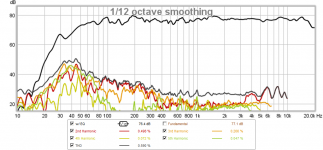 dagger-fast-hd.png148.2 KB · Views: 2,160
dagger-fast-hd.png148.2 KB · Views: 2,160 -
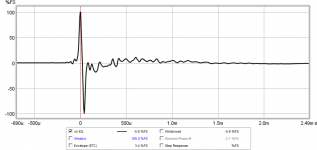 dagger-fast-ir.png43.6 KB · Views: 2,766
dagger-fast-ir.png43.6 KB · Views: 2,766 -
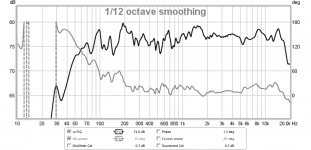 dagger-fast-phase.png92.4 KB · Views: 4,302
dagger-fast-phase.png92.4 KB · Views: 4,302 -
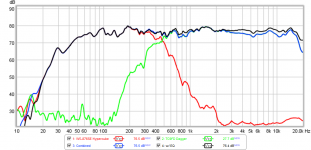 dagger-fast-xo.png97.7 KB · Views: 4,970
dagger-fast-xo.png97.7 KB · Views: 4,970 -
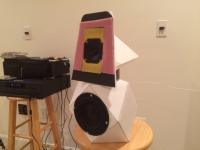 Dagger-Hypercube-FAST-photo.png323 KB · Views: 3,686
Dagger-Hypercube-FAST-photo.png323 KB · Views: 3,686
Last edited:
Interesting. I'll also put some measurements in when I get the speakers assembled. Ordered the boards pre-cut today, 24mm BB ply. So long, cabinet resonances 😀
Which measurement program do you use xrk?
Which measurement program do you use xrk?
Interesting. I'll also put some measurements in when I get the speakers assembled. Ordered the boards pre-cut today, 24mm BB ply. So long, cabinet resonances 😀
Which measurement program do you use xrk?
REW - free and highly recommended. Get a USB calibrated mic if you plan on doing any amount of measurements as a diyer. I use the UMM-6 from Dayton. UMIK-1 from miniDSP is similar. Avoid bare calibrated mics needing separate preamps as you need to have the sound card or preamp calibrated as well and it picks up noise in long cables.
I currently got this mic set: DSPeaker-MicAmp measurement kit
Got the automatic subwoofer calibration unit too, but it's currently just collecting dust as I'm using a Genelec F Two + M030 system. No room for it in between as it's mono and the measured response for that system in my room is pretty good on it's own as well.
Got the automatic subwoofer calibration unit too, but it's currently just collecting dust as I'm using a Genelec F Two + M030 system. No room for it in between as it's mono and the measured response for that system in my room is pretty good on it's own as well.
xrk971, thanks sharing the FAST setup and oh well the sound clips even it's a recording are very clean and musical.
- Status
- Not open for further replies.
- Home
- Loudspeakers
- Full Range
- FAST with TL?
